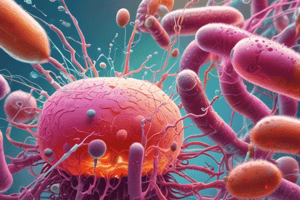Podcast
Questions and Answers
What is the purpose of a replaceable HEPA filter?
What is the purpose of a replaceable HEPA filter?
- To separate particles of different sizes (correct)
- To denature proteins
- To inhibit microbial growth
- To dehydrate cells
At what temperature does freezing typically stop microbial growth?
At what temperature does freezing typically stop microbial growth?
- 5°C
- 0°C
- -10°C (correct)
- -5°C
What is the effect of high pressure on proteins?
What is the effect of high pressure on proteins?
- It denatures them (correct)
- It has no effect on them
- It destroys them
- It activates them
What is the purpose of desiccation in food preservation?
What is the purpose of desiccation in food preservation?
What is the effect of osmotic pressure on microbial cells?
What is the effect of osmotic pressure on microbial cells?
What is the purpose of low-temperature storage?
What is the purpose of low-temperature storage?
What type of microorganisms can grow at low temperatures?
What type of microorganisms can grow at low temperatures?
What is the purpose of lyophilization in food preservation?
What is the purpose of lyophilization in food preservation?
What is the temperature required to destroy vegetative microorganisms, bacterial endospores, and viruses during autoclaving?
What is the temperature required to destroy vegetative microorganisms, bacterial endospores, and viruses during autoclaving?
What is the primary mechanism by which autoclaving achieves sterilization?
What is the primary mechanism by which autoclaving achieves sterilization?
What is the purpose of using pressure-sensitive tape or spore strips during autoclaving?
What is the purpose of using pressure-sensitive tape or spore strips during autoclaving?
What is the minimum time required for autoclaving at 15 psi and 121.5oC to achieve sterilization?
What is the minimum time required for autoclaving at 15 psi and 121.5oC to achieve sterilization?
What type of processing is autoclaving an example of?
What type of processing is autoclaving an example of?
What is the result of increasing pressure during autoclaving?
What is the result of increasing pressure during autoclaving?
What is the purpose of soaking filter paper disks in a chemical and placing them on a culture?
What is the purpose of soaking filter paper disks in a chemical and placing them on a culture?
What is the mechanism of action of phenol and phenolics?
What is the mechanism of action of phenol and phenolics?
What is the characteristic of bisphenols?
What is the characteristic of bisphenols?
What is the mechanism of action of chlorhexidine?
What is the mechanism of action of chlorhexidine?
What is the mechanism of action of iodine?
What is the mechanism of action of iodine?
What is the term for a solution of iodine in aqueous alcohol?
What is the term for a solution of iodine in aqueous alcohol?
Flashcards are hidden until you start studying
Study Notes
Autoclaving
- Increased pressure raises the temperature above 100°C and forces steam into materials being sterilized
- Autoclaving at 15 psi at 121.5°C for 20 minutes destroys vegetative microorganisms, bacterial endospores, and viruses
- Pressure-sensitive tape or spore strips can be used as a quality control measure to ensure proper autoclaving
Chemical Methods to Inhibit Microbial Growth
- Phenol and phenolics injure lipids of plasma membranes, causing leakage
- Bisphenols contain two phenol groups connected by a bridge and disrupt plasma membranes
- Examples of bisphenols include hexachlorophene and triclosan
- Biguanides, such as chlorhexidine, are used in surgical hand scrubs and disrupt plasma membranes
- Halogens, such as iodine, impair protein synthesis and alter membranes
Physical Methods to Inhibit Microbial Growth
- Low temperature inhibits microbial growth by slowing down microbial metabolism
- Examples of low temperature include refrigeration (5°C) and freezing (-10°C)
- High pressure can denature proteins
- Cold storage at low temperatures can inhibit growth, but psychrophiles can still grow
- Dessication removes water from cells, inhibiting growth and metabolism
- Osmotic pressure uses high concentrations of salts and sugars to create a hypertonic environment, causing plasmolysis
- Drying methods include desiccation, lyophilization (freeze-drying), and adding salt or sugar to food
Studying That Suits You
Use AI to generate personalized quizzes and flashcards to suit your learning preferences.




